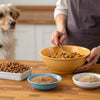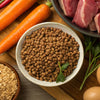Why Does My Dog Not Want to Eat Kibble? Understanding Your Pup's Eating Habits
- Houndsy
Table of Contents
- Introduction
- The Importance of a Balanced Diet
- Common Reasons for Refusal to Eat Kibble
- What to Do When Your Dog Won't Eat Kibble
- The Houndsy Kibble Dispenser: Elevating Mealtime Experience
- Conclusion
Introduction
Have you ever watched in dismay as your furry friend turned their nose up at the kibble you’ve always trusted? You're not alone. According to a study by the American Kennel Club, nearly 30% of dog owners have experienced their pup suddenly refusing to eat kibble. This common issue can leave us puzzled and concerned. After all, kibble is typically a staple of canine diets—convenient, affordable, and nutritionally balanced. As devoted pet parents, we want to ensure our dogs are happy and healthy, and a refusal to eat can signal something deeper.
In this blog post, we will explore the various reasons why your dog might not want to eat kibble. We’ll cover potential medical and behavioral causes, tips for encouraging your dog to eat, and alternatives to kibble if your pup is simply being picky. By the end, we hope to equip you with insights that will help you better understand your dog's eating habits and how to address any issues that arise.
So, as we dive deeper, we invite you to reflect on your own dog's feeding routine: Has there been a recent change? What do you typically offer them, and how do they respond? Our mission at Houndsy is to simplify and elevate your dog-feeding experience, and that begins with understanding what your dog truly needs.
The Importance of a Balanced Diet
A balanced diet is crucial for your dog's overall well-being. Dogs require a mix of proteins, carbohydrates, fats, vitamins, and minerals to thrive. Kibble is often formulated to provide this balance, making it an easy choice for many pet owners. However, when a dog refuses to eat their kibble, it can lead to nutritional deficiencies if not addressed promptly.
Nutritional Needs of Dogs
- Protein: Essential for growth, repair, and overall health.
- Carbohydrates: Provide energy and support digestive health.
- Fats: Vital for skin and coat health, as well as energy.
- Vitamins and Minerals: Important for various bodily functions, including immune support.
Understanding these needs helps us appreciate the significance of a dog’s diet and why it’s concerning when they refuse to eat kibble.
Common Reasons for Refusal to Eat Kibble
When our dogs suddenly refuse their kibble, it's essential to consider various factors that might be at play. Here are some common reasons:
1. Medical Issues
a. Dental Problems
Dental issues like gum disease, broken teeth, or abscesses can make chewing painful for your dog. If your pup shows discomfort while eating, it’s time to consult a veterinarian.
b. Gastrointestinal Upset
Conditions such as gastritis, pancreatitis, or even simple dietary indiscretion can lead to nausea or discomfort, making your dog reluctant to eat.
c. Illness
Serious health concerns, including kidney disease, liver disease, or cancer, can affect appetite. If your dog exhibits other concerning symptoms, it’s crucial to seek veterinary attention.
2. Behavioral Factors
a. Picky Eater Syndrome
Some dogs may develop a preference for treats or table scraps, leading them to snub their kibble. This behavior can be reinforced if owners give in to their dog’s whims.
b. Stress or Anxiety
Dogs are sensitive creatures, and changes in their environment (like a new home, new family member, or changes in routine) can lead to anxiety, resulting in a loss of appetite.
3. Food-Related Issues
a. Food Quality
Not all kibble is created equal. If you’ve switched brands or if the kibble has gone stale, your dog may simply not find it appealing anymore. Always check the expiration date and storage conditions.
b. Kibble Fatigue
Dogs can become bored with their food, especially if they’ve been on the same diet for an extended period. Rotating flavors or brands can help keep mealtime exciting.
What to Do When Your Dog Won't Eat Kibble
If your dog has suddenly stopped eating kibble, don't panic! Here are some steps you can take to encourage them to eat:
1. Consult Your Veterinarian
Before making any drastic changes, it’s essential to rule out medical issues. A vet can help diagnose any underlying health problems that may be contributing to your dog’s loss of appetite.
2. Make Kibble More Appealing
a. Add Toppers
Enhancing kibble with enticing toppers can make it more palatable. Options include:
- Bone Broth: Adds flavor and moisture.
- Vegetables: Steamed carrots or green beans can be a healthy addition.
- Canned Pumpkin: A great source of fiber that many dogs love.
b. Warm the Food
Warming the kibble slightly can enhance its aroma, making it more appealing to your dog.
3. Change the Feeding Routine
a. Reduce Treats
Cut back on treats and snacks to encourage your dog to eat their kibble instead. Treats should make up no more than 10% of their daily caloric intake.
b. Create a Calm Environment
Make sure your dog feels comfortable while eating. A quiet, low-traffic area is ideal for reducing stress during mealtime.
4. Explore Alternative Feeding Options
If your dog continues to refuse kibble, consider alternatives such as:
- Canned Dog Food: Often more appealing due to its smell and texture.
- Fresh Dog Food: A newer option that offers nutritious, human-grade ingredients tailored to your dog’s needs.
- Homemade Dog Food: If done correctly, this can be a healthy alternative, but always consult your vet or a canine nutritionist.
The Houndsy Kibble Dispenser: Elevating Mealtime Experience
At Houndsy, we understand the importance of making mealtime enjoyable and stress-free for both you and your dog. Our flagship product, the Houndsy Kibble Dispenser, exemplifies our dedication to innovative design and functionality. With a mid-century modern aesthetic, our dispenser not only looks great in your home but also offers:
- Perfect Portion Control: Delivering the right amount of kibble every time.
- Convenient Crank: Positioned at standing height to eliminate bending.
- Large Storage Capacity: Holds 25–30 lbs of kibble, ensuring you always have enough on hand.
Investing in a Houndsy Kibble Dispenser can simplify your feeding routine, making it easier to encourage your dog to eat their kibble consistently.
Conclusion
As we’ve explored, there are many reasons why your dog might not want to eat kibble. Whether it’s a medical issue, behavioral factors, or simply a matter of boredom, understanding the underlying cause is crucial. By consulting your veterinarian, enhancing the appeal of kibble, and considering alternative feeding options, you can help your pup develop a healthy relationship with their food.
If your dog continues to refuse kibble or shows signs of distress, remember that professional guidance is essential. Our goal at Houndsy is to support you in creating a joyful, healthy feeding experience for your beloved dog.
FAQs
1. Should I worry if my dog stops eating kibble suddenly?
Yes, a sudden loss of appetite can indicate health issues. Consult your veterinarian if this occurs.
2. What can I add to my dog’s kibble to entice them?
Consider adding bone broth, steamed vegetables, or canned pumpkin to enhance flavor.
3. How can I tell if my dog has dental problems?
Look for signs like bad breath, difficulty chewing, or bleeding gums. A vet check-up is recommended for diagnosis.
4. Is it okay to switch my dog's food frequently?
Frequent changes can upset your dog’s stomach. If you want to switch, do so gradually over a week to minimize digestive issues.
5. How can the Houndsy Kibble Dispenser help with my dog’s eating habits?
The Houndsy Kibble Dispenser promotes portion control and convenience, ensuring your dog has a reliable feeding routine that fits seamlessly into your lifestyle.
We hope this guide helps you navigate your dog’s eating habits and fosters a positive feeding experience. For more information, don’t hesitate to explore our Houndsy Kibble Dispenser and discover how we can enhance your daily pet care routine.












